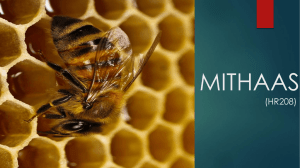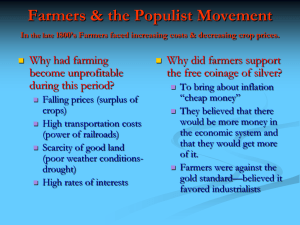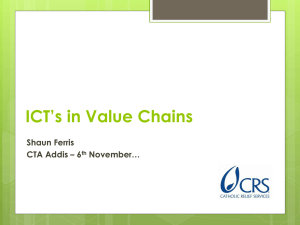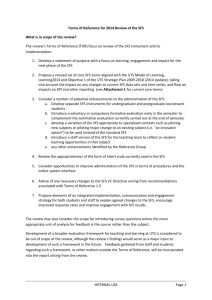Common Agricultural Policy
advertisement
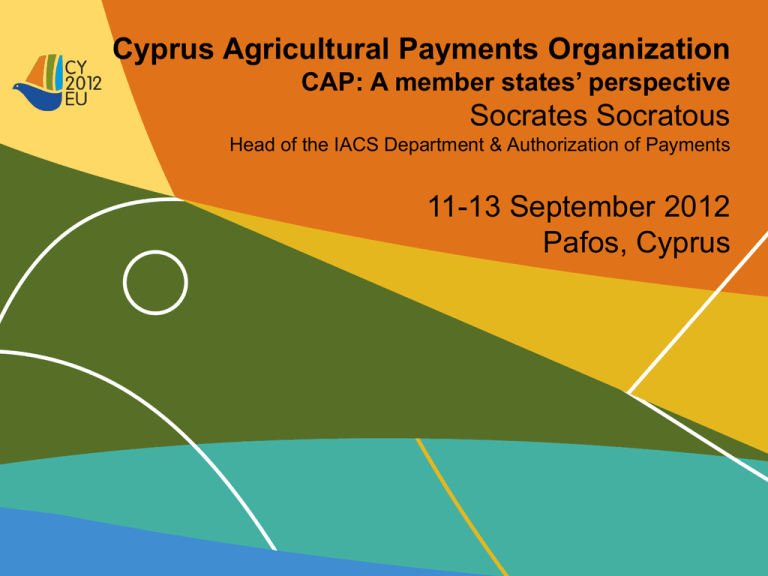
Cyprus Agricultural Payments Organization CAP: A member states’ perspective Socrates Socratous Head of the IACS Department & Authorization of Payments 11-13 September 2012 Pafos, Cyprus Welcome to Cyprus Benvenuti a Cipro Bienvenue à Chypre Willkommen auf Zypern Velkommen til Cypern Bienvenidos a Chipre Witaj na Cyprze Добре дошли в Кипър Bem-vindo ao Chipre Добродошли на Кипру Vitajte na Cypre Välkommen till Cypern Tervetuloa Kyprokselle Tere tulemast Küpros Fáilte go dtí An Chipir Dobrodošli na Cipru Sveiki atvykę į Kiprą Merħba għall Ċipru Velkommen til Kypros Welkom op Cyprus Üdvözöljük a Ciprus Bine ați venit în Cipru Добредојдовте на Кипар Dobrodošli na Cipru Vítejte na Kypru CAP: Legislative Framework The proposals take the form of four main legal instruments which will replace the existing regulations governing the CAP, as follows: A regulation governing direct payments; A regulation governing rural development payments; A regulation revising the single Common Market Organization regulation (CMO); A horizontal regulation covering financing, management and monitoring of the CAP CAP at a glance Direct Payments Market Measures Rural Development Convergence of direct Confirmation of the payments across MS. ending of milk quotas, of sugar quotas (with New basic payment to one year delay), and replace the SPS &SAPS of vine planting ban New “green” Extension of the component of DPs market disturbance New RD priorities to replace current axes Greater targeting of beneficiaries Simplification of supported measures New rules for coupled payments Changed CC rules clause to all commodities under the CMO Better coordination with other EU funds New criteria to allocate Pillar 2 funds across member states Enhanced risk management toolkit Measures to improve functioning of the food European Innovation Partnership chain Measures to support quality production Proposals on monitoring and evaluation DP Prevails Market Measures->Minor changes RD Sustainable Management of Natural resources and to climate action DP 73% EU CAP expenditure MFF ↓ real terms but ↑ in nominal terms 201339% of EU budget 202033% Pillar I 281.8Bns, Pillar II 89,9bns Additional 15.2bns. Total: 386.9bn Payments Under DP Scheme % of NC Voluntary Basic payments for farmers 43-60% Mandatory Greening 30% Mandatory Natural Constraints Areas Up to 5% Voluntary Young Farmers Up to 2% Mandatory Small Farmers Up to 10% Mandatory Couple Support Up to 5/10/+% Voluntary Complementary Nat DP for Bulgaria & Romania Specific Payment for Cotton Posei, Aegean islands Greening Practice When DO Exceptions Crops Diversifi cation Claimed Arable Land>3 hec 3 crops. None < 5% of Arable Land and none >than 70%. 1. Entirely for Grass Production 2. Left fallow 3. Crop under water Perman ent Pasture Permanent Pasture claimed Land Maintain for ever 2014=Reference 5% of Reference land EFA Claim EFA 7% of the Eligible Area excluding areas under Permanent Grassland Notes Land left fallow Terraces Landscape features Buffer Strips Afforested Areas Payment to those observing the practices relevant to them, participating to organic farming, whose holding fully or partly in areas defined as Natura 2000. MS-Gr(1) Yes to the Gr but introduce amendments Pluses: Organic farmers would automatically receive the GrP as well as Natura 2000 farmers. Ineligible land might count towards EFA obligation, which could be of real value to some farmers and take account of their biodiversity Suggestion: Extend exemptions for Greening AEM participants, harder GAEC baseline req. Skeptic: 30% of the whole DP financial envelop 85billions. Cost of greening: €33 / hec leading to 4.8% fall in farm income. compliance and penalties might also apply to the BPS = great disincentive. More clarification for penalty regime of breaching Gr. Suggestion: Reduce 30% to 20% or even to 10%. Real voluntary with out penalty effects on other schemes Instead of Greening extend CC MS-Gr(2) One size does not fit all – Menu like approach Greening Premature remove of permanent crops Suggestion: Further Gr measures identifying “win/wins” should be added to the list of measures. Diversification (the three crops rule) to cover the arable area of a farm and EFA (7% of eligible land rule) will be difficult both to implement at farm level and to control at administrative level Suggestion: 3 crops for diversification 2 crops, main crop not more than 90%, 2 main crops <95% Increase the 3 hec threshold for diversification to 5 /10 hec or even to the average size of agri holding per MS (AnnexVI). MS-Gr(3) 7% EFA requirement is too big and removes crop production and lessens the farm income accordingly Suggestion: Lower the 7% EFA req. Except livestock units growing their own feed from EFA. Except those with eligible land less than 5/10 hec. Permanent Pasture. Definition needs more clarification Suggestion: More details on the definition, 75% of eligible land Permanent Pasture Only Permanent Pasture practice. MS-Gr(4) Implementation Difficulties Crop Diversification Definition of 3 different crops should be clarified. Farmer difficulties to learn and manipulate %. Adding parts and pieces to accumulate the 5% crop requirement EFA: 7% threshold excluding permanent grassland becomes very small in applicants with less than 0,5he350m2 creating high LPIS and On spot impact. Multiple Layers on LPIS. Introduces complexity and high level of admin.cost MS-Gr(5) EFA definition lacks clarity. Buffer strips a source of controversy. Who owns New layer in LPIS. Administration cost to be updated and maintained. Controls become more complex and difficult. Dispute with farmers. Increasing the ambition of agri-environmental measures in RD Programs in Pillar 2, combined with strengthened cross compliance standards, could offer more effective environmental protection at a lower cost in terms of forgone food production [Alan Matthews, Department of Economics, Duplin University]. and farming income Small Farmers Scheme–SFS(1) Payments under the SFS shall replace the payments to be granted on BPS and VCS. Farmers participating in the SFS shall be exempted from the Gr. Farmers wishing to participate in the SFS shall submit an application by 15.10.2014 Farmers not having applied for participation in the SFS 15.10.2014 shall no longer have the right to participate in that scheme. Small Farmers Scheme–SFS(2) Amount of Payment= either an amount not exceeding 15 % of the national average payment per beneficiary (NApB).OR. an amount corresponding to the national average payment per hectare (NApH) multiplied by a figure corresponding to the number of hectares with a max. of 3. NApB= National Ceiling for 2019 / Number of farmers obtained entitlements. NApH= National Ceiling for 2019 / Number of eligible hectares declared in 2014. Small Farmers Scheme–SFS(3) If Payment<(>)€500,(€1000) Payment =€500, (€1000). CY,MA€200. During the participation in the SFS, farmers shall: a) keep at least a number of hectares corresponding to the number of entitlements held; b) eligible area not less than 1 hec (adjusted Annex IV). Farmers who by way of inheritance receive PEs from a farmer participating in the SFS shall be eligible for participation in that scheme provided they meet the requirements to benefit from the BPS and that they inherit all the PEs held by the farmer from whom they receive the PEs. MS- SFS(1) Pluses Very helpful scheme with minimum administration. A scheme towards Simplification Voices against: More suitable for MS with small farmers and not beneficial to big farmers countries “Pony paddock payment” paid to not farmers Reduce the legitimacy of the CAP support in the eyes of EU taxpayers. Art 51 imposes linear reduction not in favor to “real farmers”. MS- SFS(2) Improvements suggested Turn it to volunteer When MS circumstances justify it (especially for SF_MS), increase the threshold of 10% allocated to SFS. Introduce a kind of min. agricultural activity req. for these farmers instead of “nothing”. The CC paradox should be settled MS- SFS(3) Implementation Difficulties Art47 §4: No Payment when holding is divided Very hard to establish unambiguously this event From which date (specify). Art48: Another application by 15.10.2014! Art50§3: SF Entitlements Not transferable. When the land sold and return to BPS why not transferring the Ents as well. Complexity through the need of maintaining another kind of entity under the Ent category. Young Farmers - MS Payments to YF mandatory to MS.Optional to Farmers YF: Under 40 years old .AND. Who is setting up for the first time an agricultural holding or who have already set up such a holding during the 5 years preceding the first application. AND. Is the head of the holding Art36:MS shall grant an annual p/mnt to YF… Real problem not the subsidy but capital RD Shall Can Difficulties: date and head of the holding and more determining the 5 years preceding the appl Solution: No DP for the last 5 years. Abolish the requirement for the head of the holding NCA - Active Farmer NCA funding from both DP&RD Remove it from DP. Active Farmer DP < 5% (Total Receipts-Rec.from Agr.) How to verify that? Tax information is needed. Receipts from Agriculture sometimes very difficult to be found and defined Some businesses with significant agricultural activity because successfully diversified (tourism, banking, investment, etc) their activities would fail the test. Active Farmer Revise fundamentally. Capping Capping of payments Art11§1: 20% 100% from €150K-€300Κ DP- Disincentive to achieve economies of scales Disproportionately affect larger farmers who over time have consolidated to become more efficient Art11§2: DP- = DP-Gross salaries-GrP. Gross Salaries Difficult to calculated Contract Labor, Business Owner Labor? Art11§3: Circumvention clause –> No Payments to those artificially created the conditions to avoid the effects of the Capping Who and on which ground decides the artificially Capping (2) Many changes might occur in a farm business. Who has the burden to prove that these changes are genuine or artificial? It does not encourage business to take advantage of business structure efficiency improvement opportunities Mitigation options for Capping: Instead of gross salaries deduct predefined amounts dependent on the size of the holding Abolish capping or put higher threshold (on threshold is still an option) No deductions and increase scales thresholds Abolish Circumvention clause Capping (3) Implementation Difficulties Collect Labor Expenses Crosscheck with MS’s Competent Authorities Communication Link – Info. Availability? Capping only a few farmers, collect the capping amount to be exploited in another measure Introduces complexity on S/W systems and administration cost. Make Capping voluntary for MS Modulation – CS. National Modulation Art14§1: MS may decide (01.08.2013) to transfer up to 10% of NC to EAFRD Art14§2:Specific MS may decide (01.08.2013) to transfer up to 5% of EAFRD to DP. It could be extremely distorting. Better the budgets for Pillar I and II been defined by the outset to prevent market distortion trends. Couple support Art39: VCS may be 5% or 10% or even higher This create a Market Distortion trend. Thus limit it to 5% or even smaller. DP=15% Additional Administrative Cost. Change Management, Mind the Changes. RD Yes to axes removal. The creation of a European Innovation Partnership is also welcome. Extend Risk Management and remove it from Pillar II Shorter commitment periods. Legalize the recital which allocates 25% EAFRD to AES LFA reclassification: The introduced flexibility is welcomed and ask for more: The area covered per administrative unit instead of 66% of UAA decrease it to 50%.Allow combination of natural constraint factors to satisfy the 66% coverage. Abolish the Overlaps of EAFRD with DPs = Simplicity. Single CMO Sugar regime – a majority of member states oppose the end of this regime and would like it extended. Transition of 5 years. Producer organizations – a majority of MS opposed the proposed obligatory recognition of these organizations in all sectors, suggesting making this optional for MS. Safety nets - A number of MS would like to introduce a mechanism to update the level of reference prices. Some MS call for the phasing out of export refunds irrespective of the outcome of WTO talks, whilst others maintain they should remain for as long as the EU’s international obligations allow so. HRZ Art76 HRZ: Payments under IACS shall be made within the period from 01.12-30.06 of the following calendar year. Not allowed any more the use of N+2 reg. for AEM. Change to at least N+1 for AEM. Cross compliance : Remove the Water framework directive from CC. Some MS are opposed to the future inclusion of the Sustainable Use of pesticides directive. IACS (1) Each MS shall set up and operate an IACS that shall apply to: BPS, Gr., NCA., YFS, VCS, Cotton, SFS, Posei, Agean Islands. Supports for “afforestation and creation of woodland”, establishment of agro-forestry systems, Agri-environmental-climate measure, Organic farming measure, Natura 2000 and Water framework directive payments measure, Measure for areas facing natural or other specific constraints, Animal welfare measure, Forest-environmental and climate services and forest conservation. [Ar68-628]. IACS (2) Elements of IACS: DBs (Applicants, Parcels, Ents, Applications, etc.) LPIS for parcel identification S/W Modules: 1. Web-GIS for Ents application (2014) and for the yearly applications, 2. Web-Entitlement for transferring entitlements (banking system) and entitlement information and for Entitlement activation 3. Control System for registering and processing on the spot and remote sensing control results 4. Cross Compliance System IACS (3) 5. Application Processing System (administrative controls, application processing, calculation of eligible / payment areas per parcel, calculation of penalties, reductions and sanctions, Payments (Dapf, Naf), Recoveries, etc). Sub-systems: BPS, YFS, GrP, PfNCA, VCS, SFS, Cotton, etc. 6. Security sub-system, user administration, rights & privileges 7. Information Tracking Changes and auditing system (historical data, who / when / which / where) 8. Reporting and data mining tools. IACS abstract design Control System LPIS ComLinks BPS Applicants Parcels Claims GIS DB YFS Green Web-Ent NCA VCS SFS Cotton Agean Etc ComLinks Web-GIS Claims Entitlements NC Mgnt Security System – Data Change Tracking – Reporting Tools ΑΕΜ Timeframe – No Time Left According to estimation MS need 12-18 months to adjust or develop their systems to the new CAP. Time Left until 01.2014 16 months Regulations not yet final MEPs lodged 7,000 amendments Sanctions and penalties System has not yet defined Implementing regulations not even in draft form 30.05.2012 amendment report for the proposed regulation consisting of 71 pages and 110 amendments! At least a year extension otherwise nightmare. In two words DPs needs simplification Avoid duplication of measures on Pillar I and II Reduce the Greening Cost both for farmers and MS authorities Decouple Gr Sanctions from other Schemes Make DPs various provisions volunteer to MS AEM need more time to be paid. Mind 2014. A year extension and gradual CAP implementation is a necessity. Thank you Takk skal du ha dank u Köszönöm Dziękuję Obrigado Mulțumesc Хвала ви благодариме Ďakujem Hvala Tack Děkuji kiitos Grazzi Благодаря Merci Danke Tak Aitäh Go raibh maith agat Þakka þér ¡gracias Grazie Hvala Paldies Ačiū


